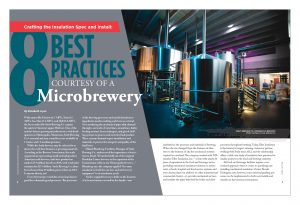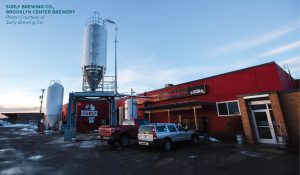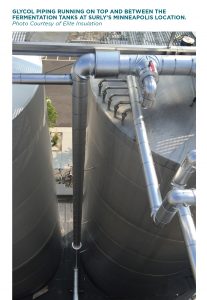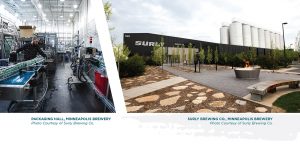With names like Furious (6.7 ABV), Xtra (4.5 ABV), Axe Man (7.2 ABV), and Hell (5.0 ABV), the beers crafted by Surly Brewing Co. capture the spirit of America’s upper Midwest. One of the nation’s fastest-growing microbreweries, with headquarters in Minneapolis, Minnesota, Surly Brewing Co.’s seasonal and year-round beers are available in 11 states and 1 Canadian province.
While the Surly brewery may be referred to as micro, the craft beer business is growing massively. According to the Brewers Association, the trade organization representing small and independent American craft brewers, craft beer production totaled 25.9 million barrels in 2018, with retail sales estimated at $27.6 billion. Surly Brewing Co. alone brewed more than 29 million pints of beer in 2017. Is anyone thirsty, yet?
Every brewmaster worth his or her hops knows good beer demands good processes. The precision of the brewing processes and careful attention to ingredients used in crafting each beer are critical. So is insulating the mechanical pipes that channel through a network of water lines, steam lines, boiler feeding systems, heat exchangers, and glycol chilling systems to process and store the final product. These systems demand expert installation and materials to protect the integrity and quality of the final brew.
Mikael Blomberg, Facilities Manager of Surly Brewing Co., underscored the importance of attention to detail. “From the build out of the original Brooklyn Center brewery to the expansion of the fermentation cellar at our Minneapolis brewery…” Blomberg says, the company applied “the same standards we hold for our beer and our brewery equipment” to its insulation needs.
Surly’s original brewery is built on the location of a former business owned by the family—one unrelated to the processes and materials of brewing. When the site changed from the business of abrasives to the business of ale, the mechanical systems required an overhaul. The company worked with NIA member Elite Insulation, Inc.—a firm with nearly 20 years of experience in the food and beverage sector, providing mechanical insulation solutions to restaurants, schools, hospital and food service systems, and even cheese plants (in addition to other industrial and commercial clients)—to provide mechanical services and insulate the pipes that feed the boiler and drive processes throughout brewing. Today, Elite Insulation is the brewery’s longest-running contractor partner, working with Surly since 2012; and the relationship offers a solid case study of insulation best practices for similar projects in the food and beverage industry.
All food and beverage facilities require a customized approach when it comes to specifying and installing mechanical insulation, Owner Brooks Holmgren says; however, some universal guiding processes can be implemented in both new installs and retrofits in the brewery environment.
The following are best practices Brooks Holmgren advises when installing insulation in the brewery/food environment.
Best Practice #1—Safety First
Hazard assessment is critical on every job, and it becomes even more critical when what is produced is consumed by people. Material handling, chemical safety, and kettle boil-over risk are just a few safety concerns present in breweries. Managing moisture and thermal performance are additional safety considerations that demand careful attention.
When retrofitting insulation in the original Surly brewery, Elite Insulation recommended a mechanical pipe insulating material that would maximize R-value and minimize condensation risk. Avoiding materials that could be conducive to the formation of mold was a top priority. “Ingredients in a food production environment have to be protected, especially when it comes to brewing beer, where key ingredients including hops and yeast need to be in carefully controlled environments,” Holmgren says. For a brewery, it made sense to specify insulation with a jacket that would look clean, wipe down easily, stay sealed, and avoid mold and mildew. In fact, the top priority was to minimize the risk of any surface providing a breeding ground for mold and mildew to proliferate. The specified insulation was from another NIA member company, Owens Corning®, SSL II® with ASJ Max Fiberglas™ Pipe Insulation, for both the retrofit and the new installation. The insulation features a plastic/polymer jacket that is smooth, durable, and wrinkle resistant. Most importantly, it does not support mold or mildew growth, even in humid environments. The flex core sizes compress over pipes and fittings, saving time up to 16% by eliminating the need to filet, and helping keep the Surly environment clean from excess debris.
Best Practice #2— Protect the Environment
Both hot and cold temperatures are required during the brewing processes to craft a great beer. Specifiers must consider how various components work together to manufacture the final product. These components include heating and cooling systems, water supply, and drainage. Collaboration and communication between the owners, engineers, and other contractors throughout the specification process can help optimize not only the installation but the quality of the end product.
The environment also must stay clean and pristine. Today’s consumers are increasingly concerned about how their food is produced, and they are interested in how the beer they drink is made. As craft brewing has grown in popularity, tours and events that connect the public to the science of brewing likewise are becoming more popular. Public tours at Surly’s Minneapolis location allow visitors to experience the brewhouse, fermentation cellar, packaging hall, and—perhaps most importantly—the finished product. Keeping the area clean and protected contributes to a safety- and cleanliness-oriented culture on the jobsite.
Best Practice #3—Manage Moisture
High humidity inside the brewing environment can support water-vapor transmission, allowing insulation and surrounding systems to get wet. Properly installed insulation helps protect Surly’s equipment from damage caused by moisture and supports the efficient operation of the system. Moisture condensation can not only present a risk for mold and mildew but also potentially oxidize, presenting a corrosive threat that damages the expensive equipment used in the brewing process.
Explained Blomberg, “Mold, leaks, and condensation can easily ruin a batch of beer during the brewing process, so it’s critical to keep it out of the brewhouse. We’ve never had an issue since day one....[The insulation] products keep the contaminants out, glycol temperatures consistent, and provide efficiency to the cooling process. All resulting in high-quality beer.”
Best Practice #4— Appearance Matters
Visit Surly for a public tour and prepare to see the processes at play. When specifying insulation for the brewery’s mechanical systems, it made sense to select insulation with a protective polymer jacket that could be easily wiped down, protecting the material not just from normal particulates in the air, but against food and beverage spills.
Similarly, Holmgren says, the food environment makes it imperative that contractors “plastic things off” during the install process. “Take time to cover and protect everything” he notes, adding that the top priority is ensuring even the most minute fiber element be prevented from entering the process environment. Holmgren noted that the closure system provides adhesive on both sides of the jacketing, eliminating the need to staple the jacket shut, and gave the owner and project engineer confidence that the material would stay sealed.
Best Practice #5— Respect the Chemistry and the Temperature Range
Temperatures are integral to the chemistry of brewing. After the grains are crushed, they are steeped in a mash, and hot water turns mash into starch. Next, the starch is converted into a simple sugar called “wort.” As insulated lines transport steam to the kettle, they support safety and improve efficiencies by regulating temperature. In the brewing business, what is hot should not stay hot forever, so a heat exchanger using more insulated lines rapidly drops the temperature, exchanging the heat for a chilled effect. At this point, yeast is introduced again. During this phase, the temperature must be carefully modulated to protect the integrity of the end product. Brew masters are experts at adjusting temperatures to create different flavors and give each beer its unique taste and personality. Glycol running between designated areas of a tank during the fermentation process helps further regulate the temperature. The glycol lines are covered with insulation to help manage moisture and control temperature.
Best Practice #6—Expect the Unexpected and Adjust
Just as brewmasters are adept at adjusting ingredients to achieve nuances with a beer’s flavor, insulating contractors often must navigate unexpected challenges on the job. For example, Holmgren discovered the valves were not properly opening and closing to control the flow of glycol. He developed, built, and installed new valve extensions that would support the stainless-steel equipment and perform reliably over a long time period.
Best Practice #7—Communicate Often
As noted in #6, the unexpected will inevitably occur, and communication between the insulating contractor, general contractor, and building owner is essential. “You don’t want to create drama, but the minute something significant comes up, it needs to be noted,” says Holmgren. During the insulation installation process, Holmgren worked closely with the owner, head brewer, and building engineer on incremental strategies to make the process go as smoothly as possible—for example, selecting the right style and placement of hangers in the system. When the job was completed, a final walk-through provided an opportunity to review the work and serve as a final quality assurance step. Simply checking off items on a list is not enough, according to Holmgren. “Always ask if the project meets expectations and if the owner is satisfied and happy with the work,” he advises. “Never assume.”
Best Practice #8—The Customer Comes First
Contractors face many challenges when it comes to balancing project deadlines and coordinating all the logistics involved when dealing with multiple suppliers on a jobsite. But among all these competing priorities, Holmgren says, it is important to remember the customer always comes first. “Sometimes it’s necessary to halt work on a project or idle a crew in the interest of making things easier for the customer,” he says. “The customer’s processes and business need to come first.”
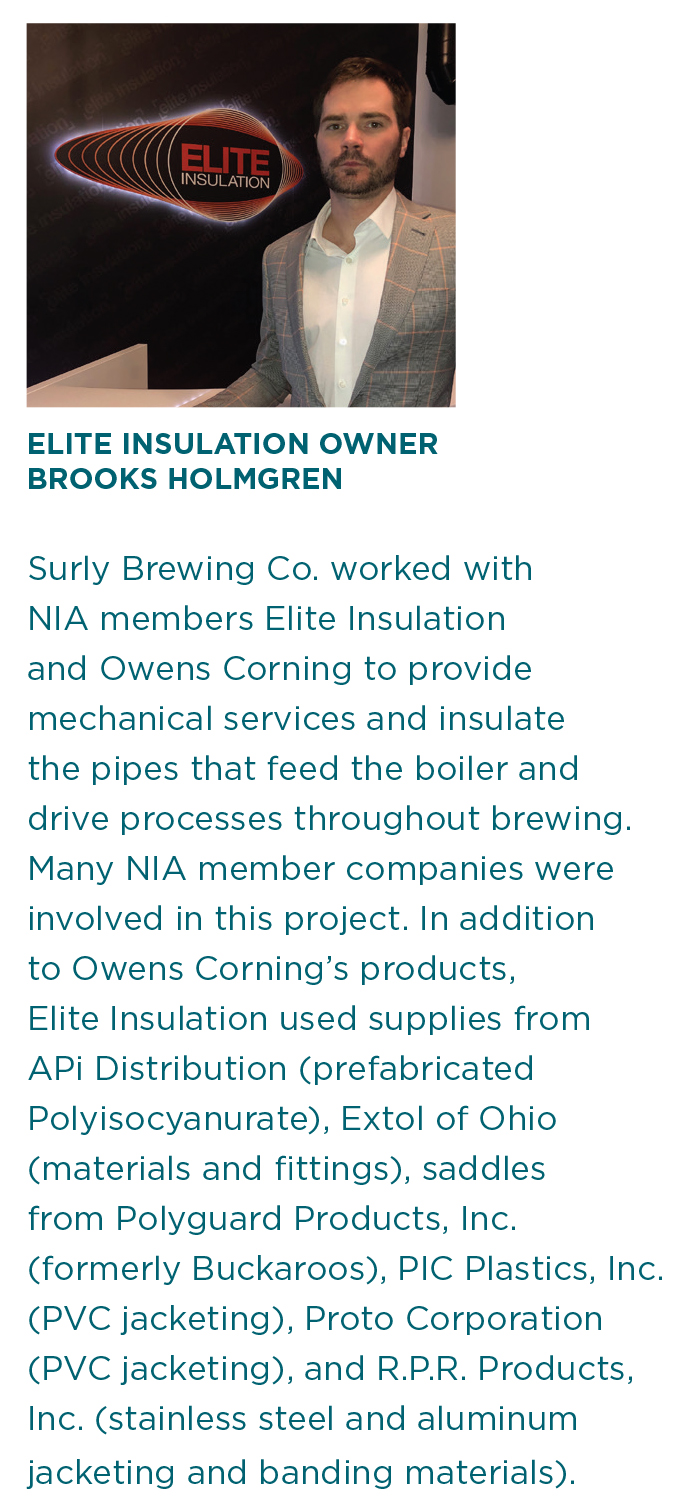
Elizabeth Joyce
Elizabeth Joyce serves as Channel Marketing Manager at Owens Corning (www.owenscorning.com). She oversees marketing for Owens Corning’s mechanical insulation portfolio and can be reached at Elizabeth.Joyce@owenscorning.com. Ms. Joyce would like to thank Elite Insulation (www.eliteinsulationinc.com) for their assistance with this article.

